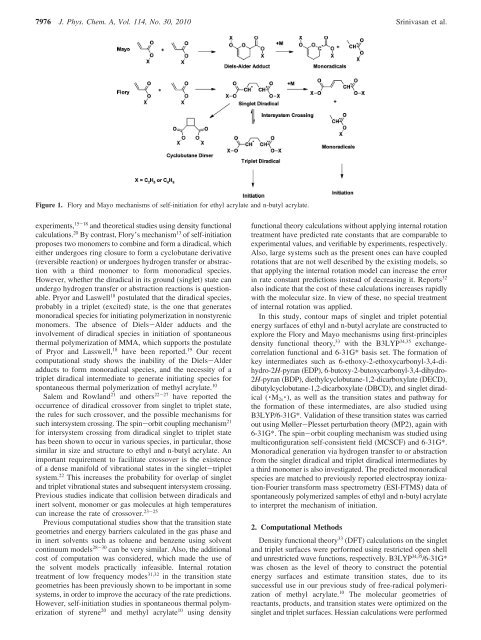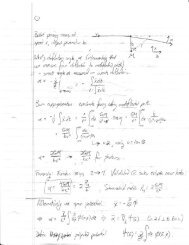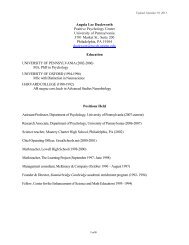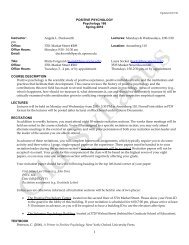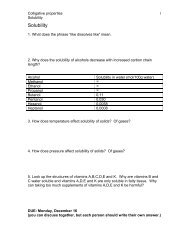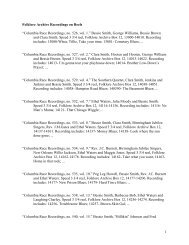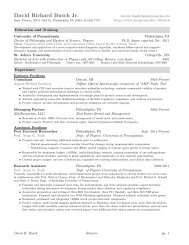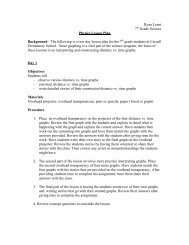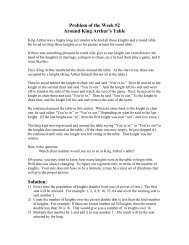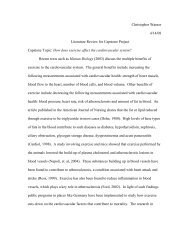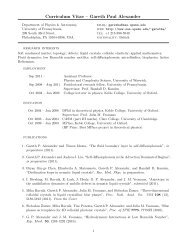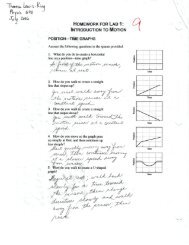Self-Initiation Mechanism in Spontaneous Thermal Polymerization of ...
Self-Initiation Mechanism in Spontaneous Thermal Polymerization of ...
Self-Initiation Mechanism in Spontaneous Thermal Polymerization of ...
Create successful ePaper yourself
Turn your PDF publications into a flip-book with our unique Google optimized e-Paper software.
7976 J. Phys. Chem. A, Vol. 114, No. 30, 2010 Sr<strong>in</strong>ivasan et al.<br />
Figure 1. Flory and Mayo mechanisms <strong>of</strong> self-<strong>in</strong>itiation for ethyl acrylate and n-butyl acrylate.<br />
experiments, 15-18 and theoretical studies us<strong>in</strong>g density functional<br />
calculations. 20 By contrast, Flory’s mechanism 13 <strong>of</strong> self-<strong>in</strong>itiation<br />
proposes two monomers to comb<strong>in</strong>e and form a diradical, which<br />
either undergoes r<strong>in</strong>g closure to form a cyclobutane derivative<br />
(reversible reaction) or undergoes hydrogen transfer or abstraction<br />
with a third monomer to form monoradical species.<br />
However, whether the diradical <strong>in</strong> its ground (s<strong>in</strong>glet) state can<br />
undergo hydrogen transfer or abstraction reactions is questionable.<br />
Pryor and Laswell 18 postulated that the diradical species,<br />
probably <strong>in</strong> a triplet (excited) state, is the one that generates<br />
monoradical species for <strong>in</strong>itiat<strong>in</strong>g polymerization <strong>in</strong> nonstyrenic<br />
monomers. The absence <strong>of</strong> Diels-Alder adducts and the<br />
<strong>in</strong>volvement <strong>of</strong> diradical species <strong>in</strong> <strong>in</strong>itiation <strong>of</strong> spontaneous<br />
thermal polymerization <strong>of</strong> MMA, which supports the postulate<br />
<strong>of</strong> Pryor and Lasswell, 18 have been reported. 19 Our recent<br />
computational study shows the <strong>in</strong>ability <strong>of</strong> the Diels-Alder<br />
adducts to form monoradical species, and the necessity <strong>of</strong> a<br />
triplet diradical <strong>in</strong>termediate to generate <strong>in</strong>itiat<strong>in</strong>g species for<br />
spontaneous thermal polymerization <strong>of</strong> methyl acrylate. 10<br />
Salem and Rowland 21 and others 22-27 have reported the<br />
occurrence <strong>of</strong> diradical crossover from s<strong>in</strong>glet to triplet state,<br />
the rules for such crossover, and the possible mechanisms for<br />
such <strong>in</strong>tersystem cross<strong>in</strong>g. The sp<strong>in</strong>-orbit coupl<strong>in</strong>g mechanism 21<br />
for <strong>in</strong>tersystem cross<strong>in</strong>g from diradical s<strong>in</strong>glet to triplet state<br />
has been shown to occur <strong>in</strong> various species, <strong>in</strong> particular, those<br />
similar <strong>in</strong> size and structure to ethyl and n-butyl acrylate. An<br />
important requirement to facilitate crossover is the existence<br />
<strong>of</strong> a dense manifold <strong>of</strong> vibrational states <strong>in</strong> the s<strong>in</strong>glet-triplet<br />
system. 22 This <strong>in</strong>creases the probability for overlap <strong>of</strong> s<strong>in</strong>glet<br />
and triplet vibrational states and subsequent <strong>in</strong>tersystem cross<strong>in</strong>g.<br />
Previous studies <strong>in</strong>dicate that collision between diradicals and<br />
<strong>in</strong>ert solvent, monomer or gas molecules at high temperatures<br />
can <strong>in</strong>crease the rate <strong>of</strong> crossover. 23-25<br />
Previous computational studies show that the transition state<br />
geometries and energy barriers calculated <strong>in</strong> the gas phase and<br />
<strong>in</strong> <strong>in</strong>ert solvents such as toluene and benzene us<strong>in</strong>g solvent<br />
cont<strong>in</strong>uum models 28-30 can be very similar. Also, the additional<br />
cost <strong>of</strong> computation was considered, which made the use <strong>of</strong><br />
the solvent models practically <strong>in</strong>feasible. Internal rotation<br />
treatment <strong>of</strong> low frequency modes 31,32 <strong>in</strong> the transition state<br />
geometries has been previously shown to be important <strong>in</strong> some<br />
systems, <strong>in</strong> order to improve the accuracy <strong>of</strong> the rate predictions.<br />
However, self-<strong>in</strong>itiation studies <strong>in</strong> spontaneous thermal polymerization<br />
<strong>of</strong> styrene 20 and methyl acrylate 10 us<strong>in</strong>g density<br />
functional theory calculations without apply<strong>in</strong>g <strong>in</strong>ternal rotation<br />
treatment have predicted rate constants that are comparable to<br />
experimental values, and verifiable by experiments, respectively.<br />
Also, large systems such as the present ones can have coupled<br />
rotations that are not well described by the exist<strong>in</strong>g models, so<br />
that apply<strong>in</strong>g the <strong>in</strong>ternal rotation model can <strong>in</strong>crease the error<br />
<strong>in</strong> rate constant predictions <strong>in</strong>stead <strong>of</strong> decreas<strong>in</strong>g it. Reports 32<br />
also <strong>in</strong>dicate that the cost <strong>of</strong> these calculations <strong>in</strong>creases rapidly<br />
with the molecular size. In view <strong>of</strong> these, no special treatment<br />
<strong>of</strong> <strong>in</strong>ternal rotation was applied.<br />
In this study, contour maps <strong>of</strong> s<strong>in</strong>glet and triplet potential<br />
energy surfaces <strong>of</strong> ethyl and n-butyl acrylate are constructed to<br />
explore the Flory and Mayo mechanisms us<strong>in</strong>g first-pr<strong>in</strong>ciples<br />
density functional theory, 33 with the B3LYP 34,35 exchangecorrelation<br />
functional and 6-31G* basis set. The formation <strong>of</strong><br />
key <strong>in</strong>termediates such as 6-ethoxy-2-ethoxycarbonyl-3,4-dihydro-2H-pyran<br />
(EDP), 6-butoxy-2-butoxycarbonyl-3,4-dihydro-<br />
2H-pyran (BDP), diethylcyclobutane-1,2-dicarboxylate (DECD),<br />
dibutylcyclobutane-1,2-dicarboxylate (DBCD), and s<strong>in</strong>glet diradical<br />
( · M 2s · ), as well as the transition states and pathway for<br />
the formation <strong>of</strong> these <strong>in</strong>termediates, are also studied us<strong>in</strong>g<br />
B3LYP/6-31G*. Validation <strong>of</strong> these transition states was carried<br />
out us<strong>in</strong>g Møller-Plesset perturbation theory (MP2), aga<strong>in</strong> with<br />
6-31G*. The sp<strong>in</strong>-orbit coupl<strong>in</strong>g mechanism was studied us<strong>in</strong>g<br />
multiconfiguration self-consistent field (MCSCF) and 6-31G*.<br />
Monoradical generation via hydrogen transfer to or abstraction<br />
from the s<strong>in</strong>glet diradical and triplet diradical <strong>in</strong>termediates by<br />
a third monomer is also <strong>in</strong>vestigated. The predicted monoradical<br />
species are matched to previously reported electrospray ionization-Fourier<br />
transform mass spectrometry (ESI-FTMS) data <strong>of</strong><br />
spontaneously polymerized samples <strong>of</strong> ethyl and n-butyl acrylate<br />
to <strong>in</strong>terpret the mechanism <strong>of</strong> <strong>in</strong>itiation.<br />
2. Computational Methods<br />
Density functional theory 33 (DFT) calculations on the s<strong>in</strong>glet<br />
and triplet surfaces were performed us<strong>in</strong>g restricted open shell<br />
and unrestricted wave functions, respectively. B3LYP 34,35 /6-31G*<br />
was chosen as the level <strong>of</strong> theory to construct the potential<br />
energy surfaces and estimate transition states, due to its<br />
successful use <strong>in</strong> our previous study <strong>of</strong> free-radical polymerization<br />
<strong>of</strong> methyl acrylate. 10 The molecular geometries <strong>of</strong><br />
reactants, products, and transition states were optimized on the<br />
s<strong>in</strong>glet and triplet surfaces. Hessian calculations were performed


